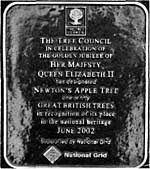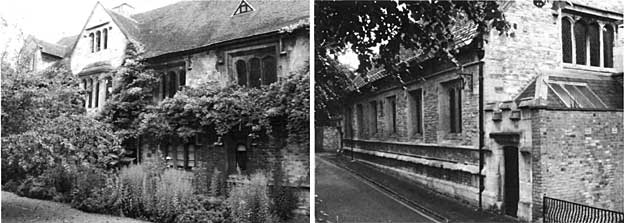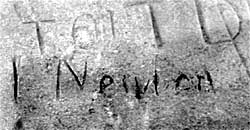Events and excursions, Summer 2009
WOOLSTHORPE MANOR, BELTON HOUSE AND THE KING'S SCHOOL, GRANTHAM
David Crook
On a pleasantly warm, although a little overcast, day nearly fifty members of the Society enjoyed a visit to three interesting places in the Grantham area of Lincolnshire, two of them closely associated with the great scientist, Sir Isaac Newton (1642-1727).
The visit began at Woolsthorpe Manor, near Colsterworth to the south of Grantham, where Newton was born and brought up between 1642 and 1654, and to which he returned in 1665-7 to undertake some of his most original scientific research during a period of plague in Cambridge.

The outside of the house, a typical farmhouse of that period, is virtually unaltered since his day, but none of the original furniture remains there and a new staircase has altered some of the internal layout. The upstairs room in which he was born contains a tablet commemorating that fact over the fireplace. Another room contains a display illustrating Newton's work on the light spectrum, while the window looks out over the garden, which contains a direct descendant of the tree from which fell the apples which led him to understand gravity.
The group moved on for lunch to Belton House, a large mansion built for the Brownlow family at the end of the seventeenth century. This gave the opportunity to explore not only the house itself but also the magnificent gardens and extensive park, including the recently restored nineteenth century boathouse at the edge of the lake.
Finally, we visited the old free grammar school in Grantham, together with the nearby schoolmaster's house.

The Master's House and The Old Hall, King's School, Grantham.

Built before 1528 and little altered since then, it is now the library of The King's School. There, members heard a talk from David Crook about the school and its important place in Isaac Newton's life, and gave an account of what is known of Newton's time there between 1655 and 1660. There was also the opportunity to see the place in the stonework of the building where he, among many other pupils, scratched his name.
The visit concluded with a fine tea provided by the school catering manager, the highlight of which was a magnificent lemon drizzle cake made with potato, which provided a memorable end to a very good day.
(See also colour images from this visit on the front and back pages of this issue. Newton was born prematurely on Christmas Day 1642. His father died shortly before the birth and his mother, Hannah Ayscough, raised him at Woolsthorpe before she moved to North Witham upon marriage to Rev. Barnabas Smith. Isaac remained at Woolsthorpe with his grandparents. His mother returned in 1653 after Smith died, together with her two daughters by him, and she ran the estate until her death.)
BOSTON STUMP, BRANT BROUGHTON and NORTH MUSKHAM
Alan Langton
Boston Stump celebrates the 700th year of its foundation in 2009, and our visit to this enormous, light and airy building took place on a delightful Spring day. The large group was divided into two to see and hear about the history and special features of the church, which includes the slender pillars of the nave, the 14th Century choir stalls with their fascinating misericords, the 17th century pulpit, the beautifully restored ceilings of the nave and chancel, and windows by Kempe and Hardman.
The bustle of a market and fair outside the church, which coincided with our visit, provided a realistic medieval feel to the occasion.
St. Helen's church at Brant Broughton, although originally a 13th century building, was heavily restored by Rector Frederick Heathcote Sutton and the architect George Bodley between 1874 and 1876; the result is what has been described as a spectacular 'medieval dream' with its clerestory and fine angel roof, a spectacular font cover and an impressive organ for such a quiet village church. Jennifer Harvey's short talk was both informative and full of justified pride for the building where she worships.
Our visit to St. Wilfrid's at North Muskham was introduced by Valerie and David Mellors, two members of the Society. This well-cared for building dates from the 13th century, and evidence of the antiquity of the church includes part of the tower, some of the Norman arcading, the studded oak door, and a now-unused stone font bowl. Other features include the medieval remains in the present screen, a fine Jacobean table and altar rails, old rafters and beams with floral bosses, and a curious alabaster pyramid dated 1591 containing the terms of the will of one John Smith.
The day ended with a splendid Thoroton' tea at Ossington Village Hall.
NEWARK MUSEUM RESOURCE CENTRE
John Hamilton
On 19 June a small group of intrepid members found their way to our meeting place behind the main railway station in Newark. The Centre may be hidden at the back of an uninviting municipal facility in the depths of an industrial estate, but it could be described as an Aladdin's Cave on two floors.
We were made very welcome by Glyn Hughes, Senior Collections Officer, and several other officers of the Newark and Sherwood Museum Service. After a brief history of Newark Museum and the Resource Centre, we were conducted (suitably wrapped up, as the collections are kept cool for preservation) into the 'cave' itself. Here we were introduced to a sample selection of items; Newark agricultural smocks from the large collection of clothing, embossed bottles from the local brewers and monstrous dinosaur teeth. We saw a collection of bicycles and many other objects of everyday living from Victorian times onwards, as well as some of the books and photographs in the store.
Downstairs were many paintings of local scenes and local worthies, hiding behind their protective curtains. Fragments of Roman mosaics and a couple of lead coffins of the same era were shown to us, part of the large numbers of archaeological remains housed there. We were able to browse freely around the store, picking out items of individual interest.
In total the Centre houses the museum's reserve collections of over 60,000 objects and over 14,000 photographs. There are over 700 pieces of art to look at, more than 300 items of costume, 30,000 items of archaeology, numerous documents, registers, poll books and early newspapers on microfiche.
We are most grateful to Glyn Hughes and his colleagues for the trouble they took over our visit. It was only a pity that more members did not take advantage of this opportunity. For those who wish to make use of these extensive holdings, the Resource Centre is open for visiting researchers on Wednesday and Thursday between 12.30 and 5 p.m; Friday 9 am to 1.30 pm and Saturday 9 am to 12 noon. An appointment is essential; telephone 01636-655777 and email museums@nsdc.info.